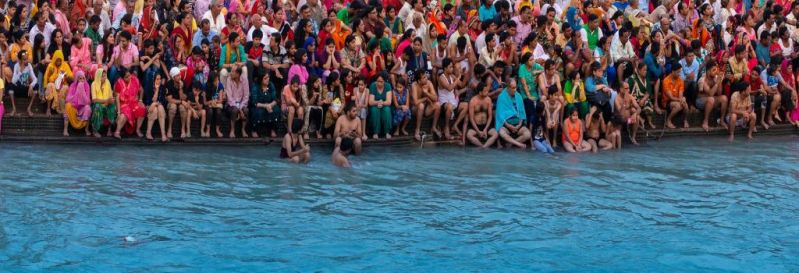Kumbh is Fine but Why is Ganga not Kept Clean All the Time?
Published on by sameer mishra, Research Scholar at National Institute of Advanced Studies, IISc Campus, Bengaluru in Social
The Uttar Pradesh (UP) government is being praised for making river Ganga’s water ‘clean’ for the ongoing Ardh Kumbh . But why can’t the same effort we made across the year, or every year during the same season?

Bathing ghat on the Ganges during Kumbh Mela, 2010, Haridwar (Image by Edson Walker / Wikimedia commons , labeled for reuse)
The state irrigation and water resources department has been releasing extra water into the river, from various barrages and dams every day since preparations for Kumbh Mela 2019 started.
Mustak Ahmad, joint secretary in the department, told Down To Earth,7,000 cusecs of extra water are being released every day since the Ardh Kumbh started and it will continue till it ends. On the days of ‘ shahi snan ’ or royal bath, 8,000 cusecs is being released.”
This year, Kumbh started on January 15, 2019, and is set to go on till March 4, 2019. The ‘ shahi snan ’ falls on February 4, 9, 10 and March 4, besides January 15 and January 21, 2019.
It seems that the government wanted to leave no stone unturned this time. A UP Pollution Control Board (UPPCB) official says, “The previous Kumbh did not see even one-tenth of this much water in the Ganga at Prayagraj. The volume of water released is at the maximum this year compared to last two-three Kumbh events.”
Gopal Nishad, a boatman at Sangam in Prayagraj, says, “We have never seen such clean Ganga earlier. Also the level of water this season seems unprecedented. Obviously, this much more water makes the Ganga appear clean like never before.”
This shows that the water quality has been improved through dilution and stopping pollutants from entering into the river. Thus, the government seems to have taken a course which implies that dilution is the solution to pollution.
Nishad’s claim finds support in data as well, since the biochemical oxygen demand (BOD) and dissolved oxygen (DO) levels are in the subscribed limits. According to the Central Pollution Control Board (CPCB), the river water can be fit for bathing if the BOD level is less than 3 mg/l, and DO is more than 5 mg/l.
Media
Taxonomy
- Agriculture
- Public Health
- Treatment
- Purification
- Technology
- Research
- Environment
- Water Supply
- Governance & Planning
2 Comments
-
This is simply a short term masking of the problem and does nothing to deal with the underlying issue. It is not a sustainable solution.
-
Dear well wishers of Ganges.
It is best to have large dugouts at locations where small streams from communities join the main River.
It would be beneficial to have road lanes at thse locations and to use mechanised JCB others to desilt dredge out sludges .
These sludges are left to dewter dry out and taken for compost process with more bio mass.
This is turned into soil improver and spread in agri farms etc.
On main river flows too, sludges are contained in large dugouts to be dealt with .
When thse wastes are reused then the communities feel confident to do more and more remediation practices.
Well wishes
Prof Ajit Seshadri.
Vels University. Chennai .
1 Comment reply
-
I am extremely pleased to hear your viewpoint. Too many want it cleaned up but not in my town, attitude. let the government do it. Wrong. The more any level of government gets involved the less that actually gets done. Sadly most of the funding is siphoned off by those in control.
I have preached the same words as you in many countries. May I suggest a few variations for convivence sake. 1. Have "dugouts/ditches/canals next to every major road. Note: the standard V shape allows for excessive evaporation. Try trapezoidal.2. Build the holding tanks sufficient for that areas use. 3. Use the RNA microbial species for the bioremediation of all the contaminated waters. Sludges will be turned back into elemental nutrients ready to be used as a natural fertilizer or as a spray on maturing compost piles. This does include all humane waste as well as any toxic materials that have found their way into the stream.
Of course entities need to stop dumping into the river. People need to learn sanitation procedures. Please call or connect if you wish. I am a board member of the Ganges River clean committee.
-